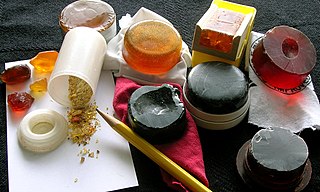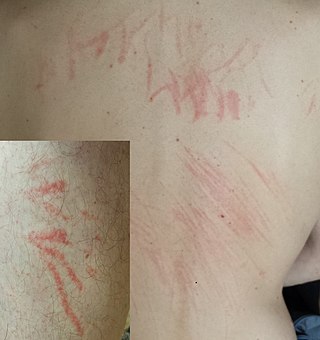Related Research Articles

Contact dermatitis is a type of acute or chronic inflammation of the skin caused by exposure to chemical or physical agents. Symptoms of contact dermatitis can include itchy or dry skin, a red rash, bumps, blisters, or swelling. These rashes are not contagious or life-threatening, but can be very uncomfortable.

Prurigo nodularis (PN), also known as nodular prurigo, is a skin disease characterised by pruritic (itchy) nodules which usually appear on the arms or legs. Patients often present with multiple excoriated lesions caused by scratching. PN is also known as Hyde prurigo nodularis, Picker's nodules, atypical nodular form of neurodermatitis circumscripta, lichen corneus obtusus.
Trichorrhexis invaginata is a distinctive hair shaft abnormality that may occur sporadically, either in normal hair or with other hair shaft abnormalities, or regularly as a marker for Netherton syndrome. The primary defect appears to be abnormal keratinization of the hair shaft in the keratogenous zone, allowing for intussusception of the fully keratinized and hard distal shaft into the incompletely keratinized and soft proximal portion of the shaft.
Plummer's nail is a clinical sign in which there is onycholysis, or separation of the nail from the nail bed, particularly affecting the ring and little fingers. It occurs in patients with thyrotoxicosis. About 5% of hyperthyroid patients display abnormal nail changes. Plummer's nail is also associated with psoriasis, traumatic injury, and allergic contact dermatitis.
Airbag dermatitis is skin irritation secondary to the deployment of airbags.
Lacquer dermatitis is a cutaneous condition characterized by a contact dermatitis to various lacquers.

Abietic acid dermatitis is a contact dermatitis often seen in association with musical instruments.
Idiopathic facial aseptic granuloma is a cutaneous condition characterized by a chronic, painless, solitary nodule, reminiscent of an acne nodule, appearing on the cheeks of young children. It has a prolonged course, but spontaneously heals.
African blackwood dermatitis is a condition characterized by an allergic contact dermatitis associated with a musical instrument made of a particular type of wood.
Uranium dermatosis is a cutaneous condition characterized by an irritant contact dermatitis and skin burns due to exposure to uranium.
Tulip fingers are a cutaneous condition, a combined allergic and irritant contact dermatitis caused by contact with tulip bulbs.
Scratch dermatitis is a cutaneous condition characterized by linear hyperpigmented streaks are seen on the chest and back.

Shiitake mushroom dermatitis is an intensely itchy dermatitis characterized by disseminated 1mm erythematous micropapules seen in a linear grouped arrangement secondary to Koebnerization due to patient scratching. It is caused by the ingestion of shiitake mushrooms and was first described in 1977 by Nakamura. Although it is rarely seen outside China and Japan due to a lower incidence of shiitake consumption outside these regions, there is a well-established association between flagellate dermatitis and shiitake mushroom ingestion. Bleomycin ingestion may also cause similar findings. On physical exam, one key difference between the two is that post-inflammatory hyperpigmentation changes are usually seen with bleomycin-induced flagellate dermatitis and are not typically present with shiitake mushroom induced flagellate dermatitis. The median time of onset from ingestion of shiitake mushrooms is typically 24 hours, ranging from 12 hours to 5 days. Most patients completely recover by 3 weeks, with or without treatment. Although the pathogenesis of shiitake induced flagellate dermatitis is not clear, the theory most argued for is a toxic reaction to lentinan, a polysaccharide isolated from shiitake mushrooms. However, Type I and Type IV allergic hypersensitivities have also been supported by the 24-hour median time of onset, clearance in 3–21 days, severe pruritus, benefit of steroids and antihistamines, and lack of grouped outbreaks in people exposed to shared meals containing shiitake mushrooms. Most cases reported shortly after its discovery were due to consumption of raw shiitake mushrooms, but several cases have since been reported after consumption of fully cooked mushrooms.
Granuloma gluteale infantum is a cutaneous condition that appears in the anogenital region of infants as a complication of diaper dermatitis.
Rheumatoid neutrophilic dermatitis is a cutaneous condition associated with rheumatoid arthritis.
Rheumatoid nodulosis is a cutaneous condition associated with rheumatoid arthritis, characterized by the appearance of multiple nodules, most often on the hands.
Giant cell lichenoid dermatitis is a cutaneous condition usually drug-associated entity, characterized by a lichenoid dermatitis with a granulomatous infiltrate composed of histiocytes and multinucleated giant cells.
Baker's itch is a cutaneous reaction caused by bites of Acarus siro, the flour mite.

C-C motif chemokine ligand 27 is a protein that in humans is encoded by the CCL27 gene.
References
- ↑ Rapini, Ronald P.; Bolognia, Jean L.; Jorizzo, Joseph L. (2007). Dermatology: 2-Volume Set. St. Louis: Mosby. ISBN 1-4160-2999-0.